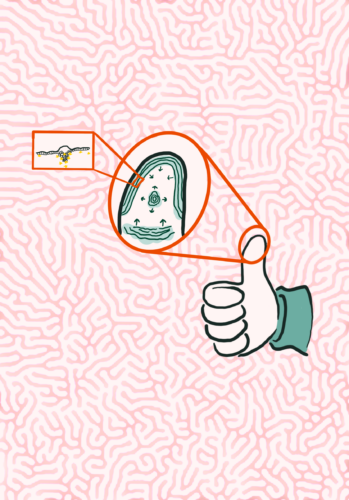Art Courtesy of Breanna Brownson
Look at your hands. Look closely at the patterns drawn on the tips of your fingers. The fingerprint is present from birth, unchanging over the human lifespan, and unique to each and every individual. Even identical twins with the same genes exhibit distinct fingerprints. So, how does your fingerprint develop? And what factors contribute to the unique patterns that you see?
Fingerprints exhibit three main pattern types: arches, loops, and whorls. Fingerprint ridges begin to form in the twelfth week of gestation, the period between conception and birth, and the organization of the fingerprint pattern is defined by week fourteen. However, little is known about the biological mechanisms underlying fingerprint variation. In a recent paper published in Cell, researchers at the University of Edinburgh and the Shanghai Institute of Nutrition and Health provide insight into the genetic foundations of fingerprint development. “We are interested in individual molecules and genes and how they work together to create structure and form,” said Denis Headon, a senior research fellow at the University of Edinburgh and an author of the study.
Leading the project, Shanghai Institute researchers in the Laboratory of Dermatogenomics performed genome-wide association studies (GWAS) linking fingerprint pattern type with genetics. A GWAS is a research approach that correlates variation in observable traits with variation in the DNA. The Shanghai researchers conducted GWAS of several thousand Han Chinese individuals characterized for the three main fingerprint patterns. This GWAS method identified forty-three locations of genes associated with developing arches, loops, or whorls.
The researchers then studied the functions of fingerprint-associated genes and the timing of their activity in development. “Interestingly, locations in the genome that correlate with fingerprint type are populated by genes involved in limb formation, rarely skin development,” Headon said. That is, genes involved in embryonic limb formation appear as the predominant factors determining heritable variation in fingerprint patterns. The researchers also found that many of the fingerprint-associated genes identified through GWAS are not even active in the skin when the fingerprint forms. Rather, the genes function early in development to set up the proportions and shapes of the fingertips. As development progresses, the genes switch off. These findings can be understood in the context of correlative work from the twentieth century, which argues that the shape of the finger strongly influences fingerprint patterns. Thus, it appears that limb development genes dictate the presence or absence of arches, loops, or whorls through their involvement in finger shape.
However, the GWAS results only explain part of the variation in fingerprints across the human population because fingerprint type is not entirely heritable. For instance, identical twins have different fingerprints, and the fingerprints of the left and right hand are not mirror images. “The same genome running through the process of making a fingerprint at different times, for different fingers, for different individuals will come up with a slightly different outcome,” Headon said. Therefore, rather than simply focusing on genes, it is important to consider development as a process. “The genes inform, but then there is a process of development that interprets and gives an outcome in the anatomy,” Headon said.
How can this study help explain the distinct fingerprints of identical twins? If one identical twin has all arches, then the other twin is more likely to have all arches than a random, unrelated member of the population. In other words, there is at least some genetic influence. “But genetic variation will go through a developmental process that has a certain amount of randomness to it,” Headon said. Simply knowing the list of genes active in a particular tissue provides an incomplete understanding of how that tissue develops. “You need to abstract a step from that and say, ‘what is the process through which these genes operate together to produce a particular outcome?’” Headon said.
Look at your hands again. How might your fingerprints have formed?

